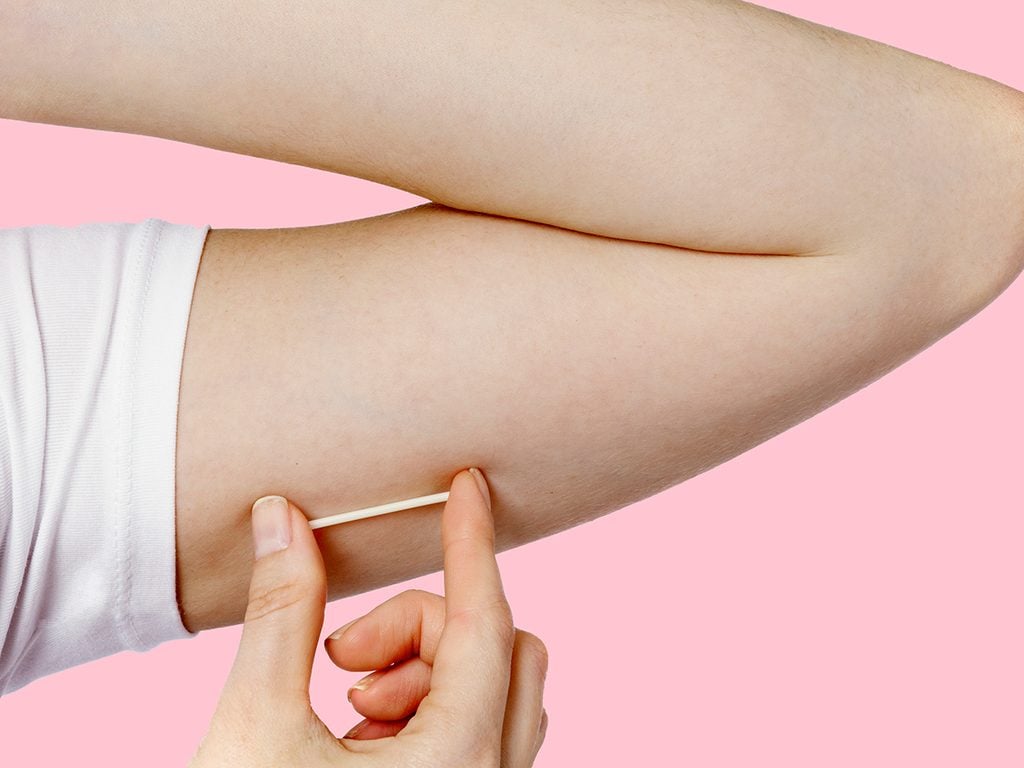Everything You Need to Know About the Arm Implant for Birth Control

A doctor explains why Nexplanon is the most effective hormonal birth control option available in Canada right now.
A device implanted into your arm to prevent ovulation, and therefore pregnancy, may sound a little freaky, but it’s actually nothing new. Due to a superior level of effectiveness, the arm implant has been a popular birth control option among women outside of Canada for a while, but hasn’t been available here since it went off the market in 2002.
Now, a new and improved version is back. Nexplanon, a single-rod arm implant (which is smaller and more comfortable than previous versions) has just been approved by Health Canada for pregnancy prevention. This three-year progestin-only contraceptive is the most effective form of birth control—even compared to an IUD, or getting your tubes tied, says Dr. Ashley Waddington, Family Planning specialist in the Department of Obstetrics and Gynecology, Queen’s University.
We talked to Dr. Waddington to find out everything you need to know about the birth control arm implant.
Who is and isn’t a good candidate for Nexplanon?
Most people are good candidates. There are very few contraindications to it, but there are a couple things to keep in mind. If somebody has a hormone sensitive tumour, like in breast cancer, I would not want to recommend this method to them. Also, it’s meant to be long-acting, which is not to say it can’t be used by someone looking for a more short-term solution, but if someone told me they’re looking to get pregnant in six months, I might think about a different method for them.
(Related: Am I Crazy for Trying to Get Pregnant During a Pandemic?)
Where in the arm is it inserted?
It’s inserted just under the skin in the upper-inside part of your arm. It goes about five millimeters below the skin, so it’s really kind of hidden. It’s not recommended to be put in some other part of the body.
How big is the rod? Can you feel it?
It’s really small—about the size of a matchstick. If you feel for it, you should be able to find it, but it wouldn’t be bothersome to you.
How is it implanted?
It’s done in a clinic by a health care provider. So, you get some local anesthetic, or what we sometimes refer to as local freezing, and it’s inserted with a little insertion device (that looks kind of like a stapler), which helps make sure the implant is inserted at the correct angle.
Do you need stitches?
The incision would be so tiny that, typically, you wouldn’t need any stitches.
Is there any recovery time?
Not really. It’s common to have a little bit of bruising at the site where it was inserted. There might be a little bit of soreness there for the first day or two. You won’t need to take time off work or anything like that, and you can go back to your activities with no restrictions.
Can you work out soon after getting the implant?
Yeah! If your arm is a little bit sore and bruised, you might take that first day off from an arm workout. But once it’s been in place for 24 hours and feels comfortable, the arm can be used again in a normal fashion.
When does it start working?
It starts to work within a few days of being inserted. We always recommend either overlapping the previous birth control method by a week, or using a backup method such as condoms for a week after the implant is inserted. It is important to note that it does not prevent sexually transmitted infections, and so condom use is always encouraged to reduce the risk of acquiring an STI.
(Related: 11 Things to Know Before Going Off Birth Control)
What if you don’t like it? Can you have it removed soon after it was implanted?
Yes! If you don’t like it for any reason, you could just go back to your health care provider to have it removed.
What are the common side effects?
Bleeding and spotting irregularities, which is really common with all progestin-only methods of contraception. It doesn’t mean it isn’t working—it could just be a nuisance. Occasionally, some people experience headaches, but that’s not very common.
If you’re having a lot of pain at the insertion site, the implant may have moved. Bring that to the attention of your health care provider—but that’s not something that’s likely to happen.
Do you still get your period?
The bleeding pattern can vary widely. You would not expect to get a regular monthly period with it in place because it is suppressing ovulation. Some people will have no bleeding at all with it in place, and others may have occasional light bleeding or spotting. Most often, the bleeding pattern that people experience in the first 3-6 months is predictive of what the bleeding pattern will be over the course of the 3 years the implant can stay in place.
If someone has been using this method for weeks or months without any bleeding and they suddenly develop new bleeding, they should be seen by a health care provider to investigate the cause (such as being screened for STIs).
(Related: Amy Schumer Wants to Talk About Your Period)
Are there any risks for choosing this implant during the pandemic? What if we go into another lockdown and it’s hard to have in-person access to a doctor?
Once it’s in place and working well, there’s not a lot of risk to having it in. What can be challenging during a pandemic is finding the resources to get it.
How do you find someone to administer it?
The first thing you would do is contact your health care provider and see if that’s something they’ve already done or if they have plans to do it. If not, then they may refer you to somebody that’s been trained.
How is it removed?
A health care provider would administer a little bit of local anesthetic, and then make a really teeny little incision, like much less than a centimeter, just about two or three millimeters at the very tip of where the rod is. Then we can pull it out from under the skin.
How soon after getting it removed can you get pregnant?
Right away! It has no long-term effect on a person’s fertility.
(Related: Why You Should Be Tracking Your Menstrual Cycle)
How much does it cost?
The cost is about $300-$350 depending on the pharmacy and dispensing costs. There is no cost to have it inserted or removed, as that is done by a health care provider.
This interview has been edited and condensed for clarity.




